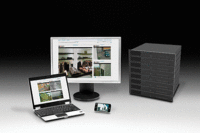As security dealers offer or consider offering personal emergency response systems (PERS), they shouldn’t overlook a potentially very helpful resource — their third-party central monitoring station. In addition to offering monitoring services tailored to PERS customers (see related sidebar, “PERS Monitoring Has Unique Requirements,” on page 70), wholesale central stations offer a wide range of PERS-related benefits — from training and conferences, to supplying and shipping PERS devices and more.
Selecting the right PERS device can be time consuming. But third-party central stations can help with that task.
PERS Devices
Several central stations SDM spoke with say they put PERS devices through testing before making the decision to support them and can offer advice on which would be the best product for a dealer’s needs.
Some central stations also stock PERS devices.
“We do it not because we want to be in the equipment business, but to create a value-added service for a dealer that only wants to order a few at a time and may not necessarily be a big enough customer for the manufacturer to set up,” observes Spencer Moore, vice president of sales and marketing for Syracuse, N.Y.-based central station Rapid Response Monitoring Services Inc.
Even if a dealer purchases PERS devices through a distributor, the central station may be able to help with getting a customer set up to use the device. For example, Lake Forest, Calif.-based central station National Monitoring Center remotely programs the serial number and international mobile equipment identity (IMEI) into PERS devices for customers.
Another role some central stations may play is to ship PERS devices to the end user.
“They tell us the name and address and we will program and ship the device to the end user,” comments Todd Shuff, vice president of operations for National Monitoring Center. “It’s all done under the dealer’s own brand.”
End users or family members generally can install the devices themselves but if they need help, National Monitoring Center customer support personnel will walk them through the installation process. National Monitoring Center serves as tier one support for the manufacturers whose products it handles, Shuff observes.
Buying PERS devices through a central station also may save money. Williamstown, N.J.-based central station COPS Monitoring plans to offer special low pricing on mobile PERS (mPERS) products, notes COPS President and COO Jim McMullen.
PERS Monitoring Has Unique Requirements
Monitoring for personal emergency response system (PERS) services has unique requirements beyond what is required for traditional security systems.
AvantGuard Monitoring’s Alex Flitton notes, for example, that AvantGuard Monitoring will create custom scripts and standard operating procedures for central station operators to follow when handling customers from an individual dealer.
Rapid Response Monitoring has operators with emergency medical dispatcher certification. According to Spencer Moore of Rapid Response, these operators are trained to focus on delivering service with a high level of empathy and care.
In addition, Moore notes that the operators can communicate symptoms to the PSAP [public safety answering point].
Mobile PERS has even more specialized requirements than traditional PERS.
Rapid Response trains central station operators on map reading, a skill that can be particularly important when directing emergency personnel to a mobile PERS customer’s location based on a map display.
National Monitoring Center did a great deal of development work to enhance its central station automation software to overcome the limitations of some global positioning systems, explains Todd Shuff at National Monitoring Center. He notes that some traditional GPS systems may have difficulty pinpointing locations within shopping malls or other large businesses that may have a single street address.
“It starts with longitude and latitude,” Shuff explains. “We’ve taken that information and put that into a GUI [graphical user interface] that gives us data about that location. Based on that longitude and latitude, we can say ‘you’re inside the mall and you’re closest to Macy’s.’”
National Monitoring Center also has worked with some individual PERS manufacturers, writing an integration between the manufacturers’ products and the National Monitoring Center tracking system. Based on this integration, a PERS device can be set up to broadcast a central station operator’s voice. In the event that a PERS customer is unable to speak, people nearby can come to his or her assistance and speak with the central station operator.
“There are important differences between PERS and mPERS,” observes Jim McMullen of COPS Monitoring. “The dispatch process is more dynamic, and therefore, more intense as dispatching to the closest nearest address assigned to a latitude and longitude of a potentially moving device is much different from dispatching to a known address.”
COPS believes the differences are so great that the company is building two dispatch centers that will be dedicated to mPERS. Dispatchers working in those centers will receive training on CPR and HIPPA compliance and potentially will get EMD certification.
Training
Another important role that central stations can play is to provide training and advice about PERS for dealer personnel.
For example, Ogden, Utah-based central station AvantGuard Monitoring does monthly webinars about devices from individual PERS manufacturers.
“We let the dealers choose which PERS device they want to use,” observes Alex Flitton, marketing coordinator for AvantGuard Monitoring.
Mark Matlock, senior vice president of sales for San Antonio-based central station United Central Control, notes that the manufacturer whose products United Central Control supports puts on webinars twice a week and dealers are required to take the training before they can sell the product.
Not all training and advice that dealers can get from their central stations about PERS is technical.
For example, COPS plans to offer mobile PERS training at each of its six sites in 2019 as part of the company’s Grow Your Business seminars.
And United Central Control offers dealers broad advice about what they’re taking on when they decide to enter the PERS business.
“We try our best to educate them that PERS is not a perfect technology,” Matlock observes. Dealers need to understand that signals may not reach everywhere, depending on the cellular coverage available, and they need to explain that to their customers, he advises.
“The main thing dealers need to understand is that their security agreement is not a PERS agreement,” Matlock notes. “They need to develop a specific agreement for PERS.”
“Dealers need to contact their insurance company,” adds Teresa Gonzalez, United Central Control president. “Not all of them are covering this.”
Dealers that handle PERS can immerse themselves in the business and technology at an annual PERS Summit organized by AvantGuard Monitoring.
Flitton describes the PERS Summit as an opportunity for dealers to create high-level partnerships with partners in the industry, “The feedback we got from some dealers was that it was a great networking opportunity.”
PERS Summit speakers have included lawyers and brokers specializing in PERS discussing topics such as how to prepare a business to be sold or to purchase another company.
Technology Enhancements
Because central stations play such a key role in supporting PERS, they also can play a key role in developing enhancements to PERS technology.
For example, central station operators’ ability to talk with PERS customers is a critical capability for the technology — and as smart speakers such as Amazon Echo and Google Home begin to catch on, it’s a logical step to integrate those devices with PERS offerings.
Central station operators at Los Angeles-based American Two-Way now can speak to end users through such products, notes American Two-Way CEO Christopher Baskin.
American Two-Way also is broadening the services it can offer for older end users to encompass additional capabilities beyond PERS. Baskin uses the term “aging in place” to describe the services, which he says are designed to enable older people to remain independent in their own homes, while also providing peace of mind to family members, who can be alerted by the central station of any potential problems.
Dealers can choose from a menu of these services to create their own offerings, which may include vehicle tracking aimed at confirming how well an elderly person is driving, Wi-Fi doorbells enabling caregivers to see anyone who comes to an elderly person’s door, and more, Baskin explains.
Clearly wholesale central stations can play a key role in the success of security dealer PERS offerings. Dealers can help ensure success by availing themselves of the wide range of value-added capabilities offered by these central stations.
More Online
For more information about PERS and mPERS, visit SDM’s website where you’ll find the following articles:
“Q&A with COPS Monitoring’s McMullen About COPS mPERS Centers”
www.SDMmag.com/cops-monitoring-mcmullen-mpers-centers
“PERS & Medical Monitoring: The Coming Convergence”
www.SDMmag.com/pers-medical-coming-convergence
“Affiliated Monitoring’s Catalyst Conference Makes a Splash for PERS Dealers”
www.SDMmag.com/affiliated-monitoring-catalyst-splash
“PERS Goes Mobile”







